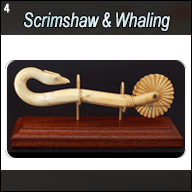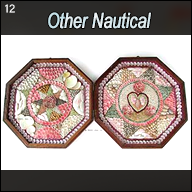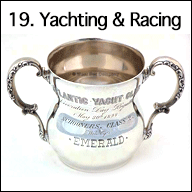8. Ship Relics
Prices in U.S. Dollars are in GREEN
 |
 |
 |
| back | back detail |
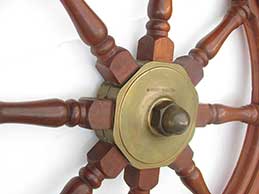 |
 |
| hub | hub back |
 |
8.98/12.17 “OLD IRONSIDES” BOOK ENDS. Scarce, highly collectable, matched pair of highest quality copper and brass bookends. These relics actually date back to 1797 when the famous frigate USS CONSITUTION was built! A raised inscription the bottom of both reads “THIS MATERIAL WAS TAKEN FROM U.S. FRIGATE CONSTITUTION 1927.” Precision cast in the form of a ship’s wheel, the center medallion features a raised portrait of the famous ship under sail. The surrounding inscription reads, “OLD IRONSDIES” / LAUNCHED 1797 / 1804 TRIPOLI / 1812 GUERRIER & JAVA / 1815 CYANE / LEVANT / U.S. FRIGATE CONSTITUTION.” The casting and inscriptions are especially well- done. These bookends each have a lead weight and a copper “foot” to insure stability as very functional bookends in addition to their historic value. 5 5/8 inches wide by 6 ¾ inches tall and 2 ½ inches deep at the base. Outstanding, untouched original condition. These tangible relics from America’s fledgling sailing Navy are now functional furnishings! Search the Internet, our price is below market. 349 / pair Launched on October 21, 1797, USS CONSTITUTION is the world’s oldest Naval ship still afloat. She is by far the oldest commissioned vessel in the U.S. Navy, and arguably the most famous. During her early exploits in the War of 1812 with Britain, she acquired the famous moniker “OLD IRON SIDES” when she engaged the British man-o-war HMS GUERRIERE on August 19, 1811. During that furious sea battle many of GUERRIER’s shots rebounded harmlessly off of CONSTITUTION’s thick oak hull. An American sailor reportedly exclaimed "Huzzah! Her sides are made of iron!" Thereafter CONSTITUTION was affectionately nicknamed "Old Ironsides". The longevity of the famed man-o-war is due largely to an effort mounted in 1927 to restore her as a commissioned U.S. Navy ship in Boston Harbor. During the restoration, the original copper hull sheathing and a large number of timbers and other fitting were removed, converted and sold as mementoes to fund the restoration. These bookends are a result of that admirable effort to tangibly preserve America’s heritage. |
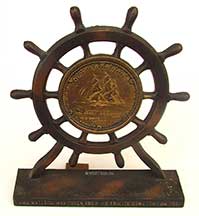 |
 |
| detail | base |
 |
| medallion |
 |
8.96 SHIP’s BELL. Authentic bell from a turn-of-the-last-century (or possibly earlier) commercial sailing vessel. This heavy duty bell is made of solid bell brass with its original iron clapper. The exterior is boldly cast in relief “J J C.” The letters are not applied but are actually part of the casting process when the bell was made. It measures 8 ¼ inches in diameter at the mouth and stands 7 ½ inches tall, weighing in at an impressive 12 pounds. The bell exhibits a dark, deep greenish verdigris indicative of the years it served at sea. The interior is painted black and the clapper exhibits minor rust, as expected of the application. This thick-walled ocean veteran produces a loud, clear, long lasting tone when rung. Bargain-priced for a bell of this quality well over 100 years old! Modern bells produced in India sell for more. 489 A challenging quest: It is certianly possible to determine the name and exact age of this identified ship’s relic. At this price, we will leave that interesting endeavor to the lucky purchaser. |
 |
| interior |
 |
8.95 SHIP’s PLAQUE. Authentic solid brass plaque removed from the entrance to the pilot house of the British passenger liner S.S. ARCADIA engraved “WHEEL HOUSE.” 4 3/8 by 1 inches. Complete with a colorful photo and write-up of the ship. Guaranteed to be original. Personally removed by us when the ship was salvaged in Kaohsiung, Taiwan in 1975. 49 |
8.45 SHIPS’ IDENTIFICATION PLAQUES. An assortment of World War II vintage non-metallic compartment plaques of various forms and sizes. All are engraved and guaranteed to be authentic. CHIEF OFFICER. 5 ½ inches. 19 OWNERS. 4 3/8 inches. 19 PILOT. 4 3/8 inches. 14 BOATSWAIN STORE. 4 1/8 inches. 19 3RD OFFICER. 5 1/8 inches. 14 2ND LIEUTENANT. 5 ¾ inches. 12 SECOND MATE. 5 7/8 inches. 14 |
 |
8.44 COMPARTMENT PLAQUES. Engraved solid brass ships’ compartment plaques from an early 1900’s Polish steamer. These authentic plaques are all 4 inches in length and bear their inscriptions in both English and Polish. SHOWER. 29 CAPTAIN’S BEDROOM. 69 PANTRY. 29 CREWS MESSROOM. 39 BOATSWOIN. (sic) 39 OFFICER’S ACCOMODATION. 49 |
 |
 |
| typical | typical back |
 |
8.43 SHIPS’ PLAQUES. Original solid brass plaques removed from various locations on ocean-going steamships built prior to World War II. This collection has been in storage for more than 30 years. Authenticity and age guaranteed. |
 |
 |
| typical | typical back |
 |
8.90 SHIPBUILDER’s PLAQUE. Genuine builder’s plate from a North American shipyard during World War II. This heavy solid bronze nameplate reads: “THE COLLINGWOOD SHIPYARDS-LIMITED. Collingwood – Ontario BUILDERS 1943” in high relief letters. The oval presentation measures 16 ½ inches wide by 10 ½ inches tall and weighs an impressive 13 pounds! It is quite unusual to see a plate of this size made during the height of the Allies’ war effort when this valuable raw material was in such short supply. That noted it is very likely from a Royal Navy warship. Excellent condition, as removed from the ship. 1200 The Collingwood Dry Dock, Shipbuilding and Foundry Company was founded in 1882 on the shores of Lake Huron, Ontario, Canada. Over the company's lifetime it built over 200 ships. During the Second World War (1940–1944), the yard was contracted to build 23 warships for the Royal Navy and the Royal Canadian Navy. Most of the ships were corvettes and minesweepers. The shipyard was closed in 1986. |
 |
| back |
 |
5.35/8.89 EARLY U.S. NAVY INCLINOMETER. Very rare surviving example of a large ship’s pilot house clinometer which saw service aboard a World War I U.S. Navy warship. This handsome all brass instrument is absolutely premium quality. It has a fine silvered brass dial which boldly displays the ship’s roll ((heel) in single degrees up to 70 port and starboard marked by 10’s. The dial is signed by the maker “Graff, Washbourne & Dunn, New York.” The complicated internal mechanism consists of a heavy pendulum bob connected to its outer indicator needle which sweeps over the appropriate degree scale. On either side are 2 brass arms which mark the extent of travel of the needle – the maximum roll encountered. To reset the arms a knurled brass knob rove though the glass moves them back to center. At the bottom of the instrument is another large knob which can be turned to lock the bob in place when not in use. To its right is a second smaller spring-loaded knob. Pressing it dampens (stops) the movement of the pendulum. This ingenious device has an 8 inch dial protected by a lovely thick beveled glass crystal. The entire instrument is 9 ¼ inches wide and 2 ¼ inches thick. The back is distinctively engraved “U.S. NAVY [N] 899.” Remarkable original condition. A real rarity over 100 years old! This is the first such identified U.S. Navy inclinometer we have ever encountered in our 40+ years. 785 Graff Washbourne & Dunn were preeminent silversmiths in America at the turn-of-the-century. A distance reading “stadiometer” dating to World War I, manufactured by Gaff, Washbourne & Dunn, circa 1917 is held in the collection of the NMAH (Smithsonian). Leading up to its involvement in the Great War America’s armed forces were woefully ill equipped to fight a global war. This fact was particularly acute in the U.S. Navy. As the Navy Department, under direction of the Secretary of the Navy, Franklin D. Roosevelt, scrambled to outfit its warships, the call went out to the civilian sector to provide (purchase or loan) all manner of equipment to enhance readiness at sea. The patriotic response was overwhelming. One such example is this inclinometer which bears the engraved Navy serial number “U.S. NAVY [N] 899.” A goodly number of loaned items were returned to their owners after the War together with a letter of thanks personally signed by FDR. |
 |
 |
| inclined | u s navy |
 |
| back |
 |
8.88 BOAT WHEEL. Early 1900'ssmall craft helm wheel. This diminutive relic with classic nautical symbolism consists of a cast bronze steering wheel fitted with wooden grips on 6 spokes with brass end caps. The inner rim is stamped “PERKO.” The central brass hub is riveted to a wooden spindle (drum) over which the tiller lines were wrapped connecting to the rudder. The body of the wheel measures a mere 5 3/8 inches in diameter measuring 12 ½ inches across, spoke to spoke. Of particular desirability are the maker’s mark and the existence of the drum, still attached. Excellent original condition noting 2 age cracks in the drum. Nice original age patina. 289 Frederick Persky, a Russian immigrant, schooled in Germany as a machinist, came to the United States in 1890 and soon found work at the Bliss Company in Brooklyn, New York. In the early 1900's he and his partner began their own business out of his house under the name F. Persky & Company, Lantern Manufacturer. In 1907, Frederick's son Louis joined him in the business, and together they enlarged their product line and manufactory. By 1912, then under the name of Perkins Marine Lamp Corporation with trademark PERKO, they were manufacturing a wide range of lanterns and marine products (See item 8.74) |
 |
 |
| perspective | spindel |
 |
| maker |

|
8.85 E.O.T. BELL. Heavy solid brass enunciator bell from a World War II vintage U.S. Navy pilot house engine order telegraph. It is marked "HENSCHEL CORPORATION AMESBURY, MASS. TYPE 3, VOLTS 6 CYCLES DC." The bell works with a loud clear tone when properly electrified. 5 inches tall by 4 inches wide. The bell is 3 inches in diameter. 5 pounds. Untouched original condition with a nice sea patina. WAS $189 NOW! 99 |
perspective |

|
perspective |
dial |
bottom |
bACK |

|
8.81 IDENTIFIED HELM BELL. Genuine mid-19th century ship's bell from the full-rigged sailing ship "CITY OF PERTH" as deeply hand-engraved on the front. This handsome solid brass bell has a hefty brass clapper which rings with a loud, sonorous, long-lasting tone. 9 inches tall by 8 ¾ inches in diameter at the mouth. Excellent original condition, showing good age, especially on the interior. 1689 |
back |
inside |

|
perspective |
hasp |
open |
interior |

|
8.76 COMMEMORATIVE TRAY. Small, very early 1900's souvenir tray from the famous Hudson River steamer the "ROBERT FULTON." This handsome tray is made of solid pewter with an extremely detailed image of the huge vessel plying the waters of the Hudson with mountains in the background. The exquisite detail bears close scrutiny under magnification. It is entitled on the bottom "DAY LINE STEAMER "ROBERT FULTON."" It is also embossed "ROBERT FULTON" on the vessel's starboard side amidships. The tray has a curvaceous ornate floral boarder in high relief. 2 ¾ by 3 ½ inches. Excellent original condition showing good age and no damage. 69 |
BACK |
SHIP |

|
8.74 BOAT WHEEL. Early 1900's small craft steering wheel. This charming little relic consists of a solid cast bronze steering wheel fitted with rich wooden mahogany grips on 6 spokes with brass end caps. The central brass hub is attached to the steering shaft by 3 screws. The shaft itself bears a 3/16 inch hole for attachment to a larger shaft by means of a taper pin. The body of the wheel measures a mere 5 ½ inches in diameter and 12 ¼ inches across, spoke to spoke. Excellent original condition with a lovely original age patina. 249 |
detail |
back |
back detail |

|
open |
interior |
detail |
back |

|
8.68/19.89 YACHT WHEEL WITH IDENTIFIED MAKER. Very handsome turn-of-the-last century steering wheel from a major yacht. This classic 6 spoke helm bears the inlaid brass maker's plate reading "American Engineering Company, Phila. PA." It is beautifully constructed with a hefty laminated rim consisting of teak inlaid with two concentric rings of a lighter blonde wood, either birch or maple, interrupted at the each spoke with inlays of mahogany. The spokes and spindles are of nicely turned oak. The hub is of heavy solid brass with a key way corresponding to the king spoke identified by the maker's label. This substantial ship's wheel measures 41 inches from spoke to spoke, 31 inches across the outer rim and weighs a hefty 24 pounds. Excellent condition with the original old finish, showing goods signs of use at sea, but no abuse. Price Request |
detail |
maker |

|
detail |
open |
left perspective |
right perspective |

|
detail |
back |
instructions |

|
8.54 SHIP’s VOICE TUBE. Very, very scarce late 1800’s flexible sound-powered voice tube. Every aspect indicates it is British. This very well-made device has a heavy solid brass “telephone” receiver and mouthpiece, both encircled by thick rubber rings. The brass handle is insulated with hand-stitched leather. It is attached by means of a wire coupling to a canvas-covered corrugated tube containing an inner spiral ribbing which provides complete flexibility with extreme durability. At the opposite end is a knurled brass coupling, secured by multiple wire turnings attached by wires, which connected it to the ship’s internal hard-mounted voice tube network. Of great significance is the fact that this early device is sound powered, accomplished by thin diaphragms of mica in the handset, which picked up and amplified the vibrations of the user’s voice. This clever system is similar in time and function to Alexander Graham Bell’s invention of the telephone using such oscillations augmented with electricity. However, on shipboard, a simplistic system sans electricity was the preferred fail safe method of interior communication. This was true whether the ship lost power, or of course if it was pre-electric. In either case the system provided a very effective means of reliable interior communication. 73 ½ inches long overall. The handset measures 11 ½ inches long by 6 inches wide. This rare shipboard relic is the first of its type we have ever seen. It is in an outstanding state of original preservation showing good use, but remarkably no abuse or damage. Without question, this is a precious survivor from the age of steam/sail, the likes of which was little valued and summarily discarded at the time of the ship’s demise. Price Request |
profile |
Hand Set |
mouthpiece detail |
fitting |

|
8.39 STEERING STATION. Early 1900’s American steamship’s steering pedestal with helm wheel. This exceptionally handsome example is made entirely of heavy solid brass. The distinctive “mushroom” pedestal is capped by a rudder angle indicator arrow on top sweeping an arc of 38 degrees, port and starboard from the amidships centerline “0.” The wheel is connected to the pedestal on a fitting with bearings and grease cup, secured by a large bonze hexagonal cap nut. The hefty all brass wheel has 8 spokes radiating to bulbous brass handles measuring 41 inches from tip to tip. The rim of the wheel is 32 inches in diameter. The gracefully tapered pedestal flares at the bottom to a massive deck flange 1 inch thick and 11 ½ inches in diameter. The entire assembly measures 50 ½ inches tall as pictured. Excellent cosmetic condition with a particularly nice, smooth high polish, showing some age spotting. A stunning original steamship relic with a bold nautical statement. SOLD |
indicat0r |

|
detail |
back |





